Dwarf Burmese Python size is dramatically smaller than the nominate race. They are more of a medium-sized snake than their giant cousins…
Last updated on February 1st, 2023 at 09:24 am
Dwarf Burmese pythons vary in size, build, and appearance as compared to their larger cousins on the mainland. Apart from being shorter, they are slimmer in overall build too. Females get to around 5.5 to 6 feet, while males reach 4 to 4.5 feet size. 8.2 ft is their greatest recorded length.
How dig do Dwarf Burmese Pythons Get?
As the name implies, the Dwarf Burmese python (Python bivittatus progschai) is a dwarf subspecies of the much larger Burmese Python (Python bivittatus bivittatus). They are not only smaller but also more slender.
Male snakes reach around 4-4.5 feet, while females can reach around 5.5-6 feet. But, the unique thing about this subspecies is that an 8 foot female would be an unusually large dwarf.
For getting a bigger clutch, some people make mainland females mate with dwarf males. This can work as the size of the female is bigger in this case.
But, when the female is a dwarf variety and the male is bigger, she can give birth only to dwarf pythons. The reason is that all eggs tend to be about the same size as dwarf eggs.
Snakes are known to take the size of their mother snakes as a maximum. So, the biggest dwarf Burmese python will be 8.2 feet long.
Dwarf Burmese Python vs Regular Burmese Python Size
Regular Burmese pythons can reach anywhere from 10 to 16 feet. Some even reach 23 feet in length, though that is exceptionally rare.
When compared to regular Burmese python size, the size of a dwarf Burmese python will be utmost 8.2 feet. In general, the maximum length of the dwarf varieties will only be half the size of regular variants.
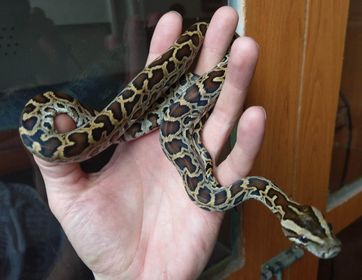
Half Dwarf Burmese Python Size
Half dwarf Burmese python is a hybrid of the dwarf subspecies mated with a regular Burmese Python. The first ever half dwarf Burmese python was produced in 2005 in the USA.
The first produced half dwarf was named F1. Following this in 2008, the second variant F2 was produced from the F1 parent. Since, then breeders have tried to stabilise the size of “half dwarfs”.
Nonetheless, its a bit of a gamble. In fact, I’ve been told by people who have bought half dwarfs that some of them have gotten well over 6 feet in length, and much heavier than true dwarfs.
It is entirely possible for half Dwarf Burmese Pythons to reach and even exceed 8ft in length. If you really want a Burm’ that stays at a manageable size then I highly recommend waiting until you can find a 100% dwarf animal, i.e. a purebred Python bivittatus progschai.
Dwarf Burmese Python Temperament
One key factor that keeps people away from dwarf Burmese pythons is their notoriously grumpy nature. This subspecies is always ready to bite, especially when wild-caught.
But, the relieving thing is that you will not find this personality in the third-generation dwarf Burmese python. The first and second generations are aggressive comparatively. Over time, captivity just seems to tame them down with each passing generation.
The third generation can be as tame as their mainland cousins. Also, if you are considering breeding, you can choose to breed a calmer half dwarf Burmese python.
If you are looking for a calmer pet, go for an F3 or later generation of Dwarf Burmese python. Sometimes the juveniles are still a little nippy, but they quickly become tame with repeated, gentle handling.
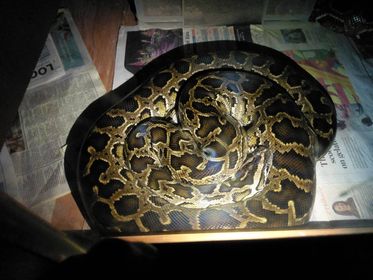
Dwarf Burmese Python Care
Before buying a Dwarf Burmese python, you should be aware of how to care for it. When it comes to caring for these reptiles, there’s a few main points to get right to ensure success. I’ve listed the main ones here, but a full, comprehensive care sheet is coming soon to fill in the gaps.
Feeding
To make sure that dwarfs do not try to escape, you should feed them regularly. Rats are essential feeds for this snake variety.
You should make sure to feed them with a meal a little greater than their girth every 5 to 7 days when young, then every 10 to 14 days when adult.
But, you should remember one thing when you are petting and caring for them. Dwarf Burmese pythons can get overweight very quickly. So, you should keep a watch on their weight as well.
Also, dwarfs occasionally like to strike at their food a couple of times before consuming it. So, make sure to use forceps when feeding them with caution.
Temperature and humidity
These snakes are tropical, and like their larger cousins from the mainland need nice, consistent temperatures of around 78-80F on one side of their enclosure and 85-89F on the other.
For humidity, they come from reasonably areas, so it needs to stay around 60-70%. They should also have a large water bowl available at all times to soak in.
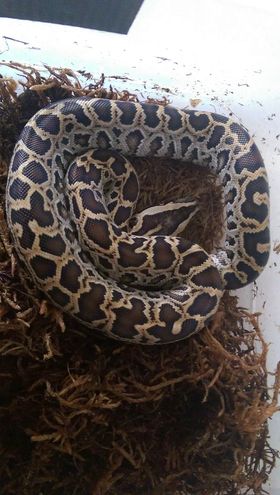
Hides
When you grow a dwarf, you should remember one thing: They are a nervous and shy species. You should take steps to make them feel secure. Otherwise, they can turn defensive.
It is better to make sure that you provide this snake with two hides. One hide can be on the hot side of the enclosure and the other on the cold side.
You might find your snake not using the hides. Nevertheless, it is better to keep them as in case she needs them, she can hide. Suitable hides include:
- Exo Terra (resin) caves for juveniles
- plastic snake caves
- large pieces of cork bark
- large pieces of hollowed out drift wood
Dwarf Burmese Python Tank Size
When it comes to providing good husbandry, finding the right housing is the first step. The ideal enclosure sizes for this species are listed below:
| Your Snake’s Length: | Recommended enclosure size: |
| 2 to 3 ft | 24inch long vivarium, or plastic tub with a capacity of 25-30l/6.6-8g |
| 3 to 5 ft | 36inch long vivarium, or plastic tub with a capacity of 50l/13g |
| over 5ft | 45 inch long vivarium or pvc enclosure |
As these snakes get to a maximum of 8.2 feet, you might wonder why not go for bigger enclosures. Experts recommend that if they are kept in a larger enclosure than their length, they get more defensive.
When they are defensive, they can become irritable or very stressed as you know. So, when caring for dwarf Burmese pythons, the right enclosure size is the first thing you will have to consider.
With shy subspecies like this one, it’s also important to choose correctly where to put their enclosure. It should be somewhere calm, without a lot of people or disturbance around it.
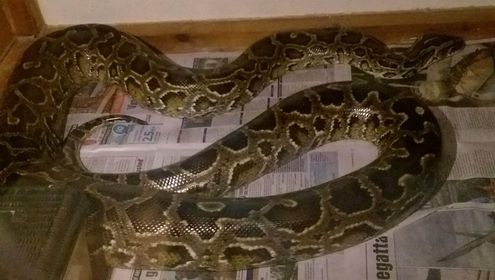
Dwarf Burmese Python for Sale and Price
Price is the biggest issue for those interested in buying a Dwarf Burmese python. The dwarf variety is much more expensive as compared to mainland pythons.
Half-dwarf Burmese pythons are much more affordable. But, if you want a pure dwarf Burmese python, you should be ready to spend around $1000.
The reason for the huge cost of dwarf Burmese pythons is that they are a rare subspecies in captivity. As costs also vary based on morphs some people breed for morphs by reproducing with mainland snakes.
This is why pure snakes are considered valuable and rare. You can find breeders for buying dwarf Burmese pythons on Morphmarket.com, or occasionally in large, specialist exotic pet shops.
When selecting a breeder to buy, make sure to read reviews. Only then, you can get pure dwarf Burmese python.
In the UK and Europe, you can sometimes buy dwarf Burmese pythons for around £400. The price might vary on the basis of availability. When you are buying from foreign countries, make sure to consider shipping costs. You can find classified in local reptile shops as well.
Half Dwarf Burmese Python for Sale and Price
As far as price goes, half dwarfs can cost somewhere around $400 to $700. Half-dwarf Burmese pythons are affordable as compared to their dwarf counterparts.
Even, the price of half dwarf differs from one morph to another. Among them, quarter snakes are the most affordable options based on their morph.
Even in this case, quarter variants that belong to the rare morph category will cost you more. You can buy half dwarfs at around €200 from the UK and Europe.
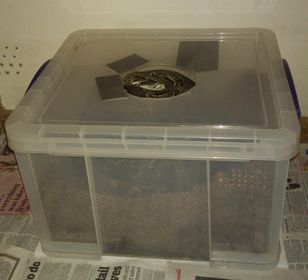
FAQ Relating to Dwarf Burmese Python Size:
How long do dwarf Burmese pythons live?
Dwarf Burmese pythons can have a lifespan similar to their mainland cousins. You can expect them to live for around 20 years. Even hybrids can live this long unless they have inherited bad genes. Similar to humans, the lifespan relies on how their weight is maintained.
If you are particular about expanding the life of dwarf Burmese pythons, make sure not to overfeed them. The way fat is stored in snakes can reduce their life expectancy.
Particularly, dwarf Burmese pythons can quickly gain weight if you overfeed them. By the time you see that your snake has gained a lot of fat externally, it has already gained a lot internally.
The life of these tiny pythons reduces mainly because people feed them similarly to their mainland counterparts. You should feed your pet only on the basis of its size to help it live a long life.
How big is a one year old Burmese python?
Skilled breeders offer captive Burmese pythons better conditions than those encountered by wild Burmese pythons. So, those grown in tanks are likely to grow more quickly as compared to those living in the wild.
Burmese pythons in captive conditions easily reach 6 feet within 6 months of their birth. Reptiles Magazine states that these reptiles growing in captive conditions reach 10 feet within their first birthday.
What size tank does a Burmese python need?
For a 6-8 feet long Burmese python, a 75-gallon tank is needed. In the case of an adult female Burmese python, it will need an enclosure of at least 72 x 36 inches.
Extra-long variants even need bigger enclosures of up to 96 inches. If this sound too big, try to find a breeder online who is working with Dwarf Burmese Pythons instead.
Do all Burmese pythons get big?
True Burmese pythons (Python b. bivittatus) reach 10-16 feet in total length. Those growing in captive conditions reach this length quickly. There is a smaller subspecies called the Dwarf Burmese Python (Python bivittatus progschai), however, which may only reach 4.5 to 6 ft in length when fully grown.

